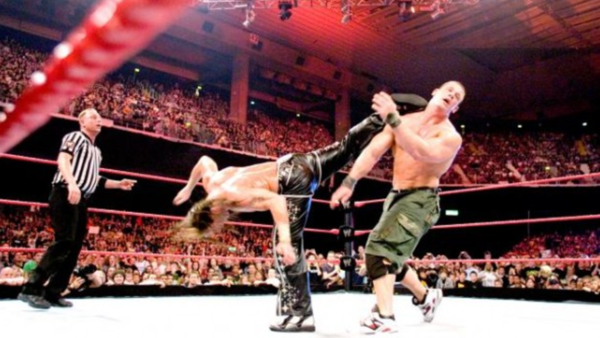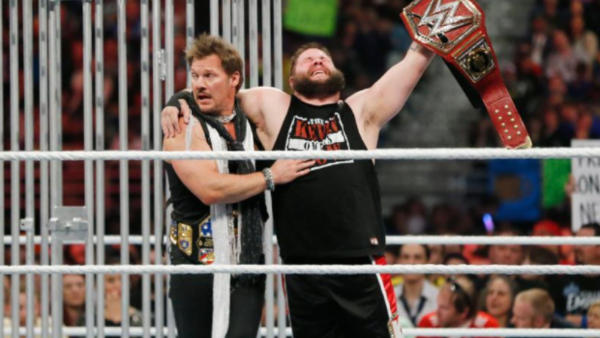Has Episodic Television Irreversibly Damaged WWE's Product?
Rematch City.

Episodic weekly television remains WWE’s most lucrative revenue stream. There is no argument to the contrary, no way things are going to (or should) change - but it is both lifeblood and disease.
The Monday Night Wars exacerbated the WWF’s early 1990s approach to primetime television. Monday Night RAW debuted on January 11, 1993, at which point the Golden Age had receded in parallel with the depletion of the national talent pool. Hulk Hogan was no longer a full-time attraction. The Ultimate Warrior was gone just as soon as he had returned. Ric Flair worked out in the ring, but not at the box office.
The old formula of presenting squash matches on television, between midcard acts and local jobbers, was untenable. Hulk Hogan was barely on basic cable, but he did not need to be. The WWF did not need to overexpose him because he was a gigantic pay-per-view and house show drawing attraction, one whose televised in-ring appearances were special precisely because they were so scarce.
With fewer household names at their disposal, the WWF mitigated the free fall in popularity by presenting matches on the nascent RAW brand between two name stars. It was a revelatory and necessary step, but the biggest matches were still withheld for pay-per-view main events. Ric Flair Vs. Mr Perfect was an aberration necessitated and justified by Flair’s imminent exit. There was never any question of casually tossing out something like Bret Hart Vs. Owen Hart on, say, the episode of RAW before WrestleMania X. Even the second-tier attractions were reserved for the big shows.
The rise of WCW compounded the approach. The WWF had to press on with the strategy, which no longer warranted the designation. It was no longer an experiment; it was the norm.

By 1999, the company was handily thrashing WCW Nitro in the ratings battle, during which time established headliners The Rock mostly defeated lower undercard fodder like Gangrel and the Big Boss Man on television. Major matches, like The Rock Vs. Triple H, ended in no contests.
The WWF’s pyrrhic Monday Night Wars victory precipitated another downturn in business, but by that point there was no question of reverting back to the Hogan house show formula. The paradigm had been shifted. There was no turning back but a doubling down. Televised pay-per-view rematches became more frequent; Shawn Michaels challenged for John Cena’s WWE Title just over three weeks after he had failed in his last quest at WrestleMania 23. The rematch was far longer, far better, and drew by design considerably less money. It foreshadowed what we are subject to today.
In 2017, the episodic TV model has devalued almost every aspect of the company.
Stars no longer feel like stars because their appearances are so commonplace as to be mundane. Stars no longer feel like stars because they all read from one homogenised script. Stars no longer feel like stars because they’re not. They are soap opera actors.
Pay per views don’t need to be the ticket-selling marquee events they once were because the company already has your Network subscription. Kevin Owens and Roman Reigns wrestled on RAW so often in late 2016 because the requirement to fill fruitful TV airtime was more important than creating a special and novel aura around their feud. WWE already had your money, but they needed your viewership. TV earns the company considerably more than the Network. WWE’s new strategy is to “super-serve” content to a diehard fanbase. It matters little that said content is a mindless and ceaseless succession of retreads. In a way, it has to be.

Conversely, WWE knows they cannot merely promote endless rematches with no rhyme nor reason. It does not perceive the audience as entirely undiscriminating, despite some unfortunate evidence to the contrary. The episodic TV model demands hooks to grip viewers week-to-week, which WWE has created by shattering the pattern with which it rose to the apex of the wrestling world. The Bruno Sammartino and Hulk Hogan - even the Steve Austin model, of dashing and inspiring hope in cathartic mini-cycles, is stone dead. With no season finale in sight, WWE instead prefers to position heels on top, particularly as the year draws to a close, holding onto their gold with brain-deadening predictable chicanery devoid almost entirely of logic, all to inspire apparent hope for a babyface who invariably is not the man fans want. Why was Chris Jericho permitted to interfere throughout every one of Kevin Owens’ matches with no reprisal? Is it because RAW is managed (or commissioned, whatever, they are interchangeable) by a permissive heel, Stephanie McMahon? Wasn’t Stephanie up in arms at the chaotic state in which RAW found itself under Mick Foley’s management, one Jericho revelled in?
Why does so little of any given episode of RAW make even the faintest semblance of sense?
The answer, invariably, is thus: to get to the next show, the next town. The means is meant to justify the end, but wrestling never ends. There is no off-season. No conclusion. Just an endless routine of repetition and retcon. Wrestling used to be a reassuring exercise in conflict and release; within the episodic TV paradigm, WWE instead infects its fanbase with a painful and unsatisfying case of blue balls.

The writing on RAW is terrible, but SmackDown Live exists as a beacon of optimism. The storylines are usually well-crafted, engaging, and even dovetail into one another with a rewarding and sensible shared universe methodology. Even then, the further SmackDown removed itself from the orbit of WrestleMania, the only event approaching a season finale, the more the quality unravelled. The show had to spin on its wheels. The mud that was the AJ Styles versus James Ellsworth rivalry covered our faces. Moreover, the rigid model has still enabled WWE to indulge its most counterproductive whim: giving away matches on free television.
At least, with the recent Randy Orton Vs. AJ Styles No. 1 Contender’s bout, there was a fundamental storyline reason for its existence - but when WWE inevitably revisits the pairing on pay-per-view, it will no longer possess its unique appeal. It’s difficult to conceive of any potential major match, wrestled by two full-time stars, which hasn’t already been done to death. Samoa Joe has already faced Roman Reigns since his recent debut. He’s been on the main roster for a cup of coffee. When he inevitably feuds with Seth Rollins, post-Mania, he will have already squared off against the top two babyfaces on the roster in less than a quarter of a year. It’s madness, but WWE cannot fill TV time with local enhancement talent. They can’t even fill it with midcarders. The model has existed for so long that fans (and sponsors) cannot accept a substitute.
The format has demanded the oscillation of content and star power. It is the nature of the beast. WWE needs the stars to appear on it, but appearing on it dulls their star power.
The never-ending, unremarkable episodic TV model has trapped WWE in a paradox of never-ending circular logic, one which cannot be broken because, even if the writing transcends it, the format exists to over-consume, eventually.